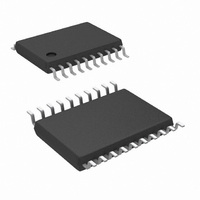LMX2433TMX/NOPB National Semiconductor, LMX2433TMX/NOPB Datasheet - Page 32

LMX2433TMX/NOPB
Manufacturer Part Number
LMX2433TMX/NOPB
Description
IC SYNTHESIZER DL 3.6GHZ 20TSSOP
Manufacturer
National Semiconductor
Series
PLLatinum™r
Type
PLL Frequency Synthesizerr
Datasheet
1.LMX2433SLEXNOPB.pdf
(49 pages)
Specifications of LMX2433TMX/NOPB
Pll
Yes with Bypass
Input
CMOS
Output
CMOS
Number Of Circuits
1
Ratio - Input:output
3:2
Differential - Input:output
Yes/No
Frequency - Max
3.6GHz, 1.7GHz
Divider/multiplier
No/No
Voltage - Supply
2.25 V ~ 2.75 V
Operating Temperature
-40°C ~ 85°C
Mounting Type
Surface Mount
Package / Case
20-TSSOP
Frequency-max
3.6GHz
For Use With
LMX2433EVAL - EVALUATION BOARD FOR LMX2433
Lead Free Status / RoHS Status
Lead free / RoHS Compliant
Other names
LMX2433TMX
www.national.com
LMX243x FinRF Input Impedance Test Setup
The block diagram above illustrates the setup required to
measure the LMX243x device’s RF input impedance. The
same setup is used for the LMX2430TM Evaluation Board.
Measuring the device’s input impedance facilitates the de-
sign of appropriate matching networks to match the PLL to
the VCO, or in more critical situations, to the characteristic
impedance of the printed circuit board (PCB) trace, to pre-
vent undesired transmission line effects. The FinIF input
impedance is evaluated in the same way.
Before the actual measurements are taken, the Network
Analyzer needs to be calibrated, i.e. the error coefficients
need to be calculated. The Network Analyzer’s calibration
standard is used to calculate these coefficients. The calibra-
tion standard includes an open, short and a matched load. A
1-port calibration is implemented here.
To calculate the coefficients, the PLL chip is first removed
from the PCB. A piece of semi-rigid coaxial cable is then
soldered to the pad on the PCB which is equivalent to the
FinRF pin on the PLL chip. Proper grounding near the ex-
posed tip of the semi-rigid coaxial cable is required for
accurate results. Note that the DC blocking capacitor is
removed for this test. The Network Analyzer port is then
connected to the other end of the semi-rigid coaxial cable. In
32
this way, the semi-rigid coaxial cable acts as a transmission
line. This transmission line adds electrical length and pro-
duces an offset from the reference plane of the Network
Analyzer; therefore, it must be included in the calibration.
The desired operating frequency is then set. The typical
frequency range selected for the LMX243x device’s RF syn-
thesizer is from 100 MHz to 6000 MHz.
The Network Analyzer calculates the calibration coefficients
based on the measured S
calibration is now complete.
The PLL chip is then placed on the PCB. A power supply is
then connected to Vcc. The EN, ENosc, and OSCin pins are
all tied to Vcc. Alternatively, the OSCin pin can be tied to
ground. In this setup, the complementary input (FinRF
AC coupled to ground. With the Network Analyzer still con-
nected to the semi-rigid coaxial cable, the measured FinRF
impedance is displayed.
The OSCin input impedance is measured in the same way.
The impedance is measured when the oscillator buffer is
powered up (ENosc is set HIGH) and when the oscillator
buffer is powered down (ENosc pin is set LOW).
11
parameters. With this all done,
20053591
*
) is











